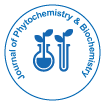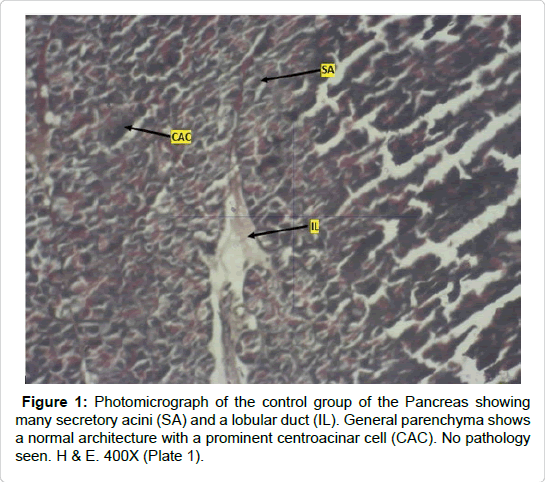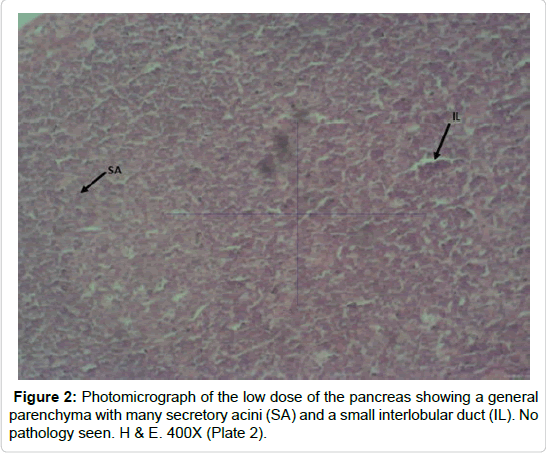Histology of Pancreas of Wistar Rats Treated with Aqueous Extract of Afang Leaf
Received: 31-Jul-2018 / Accepted Date: 31-Aug-2018 / Published Date: 10-Sep-2018
Abstract
Abstract
Objective: This study was meant to investigate the effect of aqueous leave extract of Gnetum africanum on the microanatomy of the pancreas in adult male.
Methods: Wistar rats, eighteen adult Wistar rats weighing between 80 g-150 g allotted into three groups of six rats each was used for this study. Animals in group 1 served as the control group were fed with normal rat chew and distilled water, while group 2 and 3 served as the experimental groups treated with Gnetum africanum leaf extract, orally for 21 days. Group 2 (low dose group) animals were treated with 0.3 ml/kg body weight of the extract, while group 3 (high dose group) animals were treated with 0.5 ml/kg body weight of the extract. At the end of experiment, all animals were sacrificed under chloroform inhalation and the pancreas removed for histological observation using Haematoxylin and Eosin (H & E) stain.
Results: Histological observations from the study showed normal histological findings in the control and low dose group with no observable pathology. Meanwhile the high dose treated group showed pathological observation suggesting a prognosis of acinar cell cystadenocarcinoma.
Conclusion: From the result of the study, it may be deduced that consumption of Gnetum africanum, at moderate dosage, may have no adverse effect on the pancreas, but at high dosages, the extract may cause some pathological distortion to the microanatomy of the pancreas.
Keywords: Gnetum africanum; Wistar rat; Pancreas; Microanatomy
Introduction
Herbal medicines are often used to provide first-line and basic health service, both to the people living in remote areas where it is the only available health service and to people living in poor areas where it offers the only affordable remedy. Even in some developing areas such as Nigeria where modern medicine is available, the interest on herbal medicines and their utilization have been increasing in the recent years [1].
Some of these plants that exhibit medicinal properties have been known to help in stabilizing different internal organs in animals, while other have side-effect on the organs due to varying amount of toxic matter present in such plants [2]. The use of herbs requires good knowledge of the toxicity dosage, purity, suitable extraction solvent and adverse effects [3]. The prolonged usage of these herbal products without proper monitoring of the usage had brought about a number of health related problems like infertility which is a common problem affecting most couples all over the world [4]. Decline in male fertility has been a great concern from time as male infertility accounts for about 30% of fertility cases worldwide [5].
Afang (G. africanum) is a medicinal plant usually found in humid tropical forest regions of Cameroon, Gabon, Angola as well as Nigeria, which does not grow well in direct sun light and can be found climbing on middle and under-story tress [6]. G. africanum has various uses among which the leaves are used as vegetable for soups and stews, commonly called Eru soup or Afang soup [6]. Medicinally, the leaves are used as remedy for nausea, sore throats and for warts dressing, while the steam may be eaten to reduce pain during childbirth [7]. G. africanum has numerous common names and is grown in various countries across Africa including; Cameroon (Eru, Okok, m’Fumbua, or Fumbua), Angola (koko), Nigeria (Ukazi or Afang), Gabon (Koko), Central African Republic (Koko), Congo (Koko) and the Democratic Republic of Congo (m’Fumbua or Fumbua).
The pancreas is a glandular organ in the digestive system and endocrine system of vertebrates. In humans, it is located in the abdominal cavity behind the stomach. It is an endocrine gland producing several important hormones, including insulin, glucagon, somatostatin and pancreatic polypeptide, all of which circulate in the blood [7]. Pancreas is also a digestive organ, secreting pancreatic juice containing bicarbonate to neutralize acidity of chime moving in from the stomach, as well as digestive enzymes that assist digestion and absorption of nutrients in the small intestine.
Materials And Method
Extract preparation
G. africanum leaves were gotten from Ikom Local Government Area of Cross River State, Nigeria. The leaves were plucked and dried at a room temperature of about 27°C for about four weeks. The leaves were blended to fine powder using a grinding machine. The blended sample of G. africanum leaf powder was weighed using digital weighing balance and was found to be weighing 120 g. The blended leaf was macerated with 1000 ml distilled water and the mixture was left four 48 hours at 20°C mixture was filtered, after which cheese cloth was used for filtration followed by filter paper (Whatman No. 1).
Experimental animals
The Eighteen fit and matured adult male Wistar rats weighing between 80 g-150 g were purchased from the animal house of the Department of Human Anatomy, Cross River University of Technology, Okuku. The entire animals were kept in aluminum cages covered with wire mesh in standard laboratory environment. All animals were given water and commercial feed and allowed to rest and acclimatize for two weeks before commencement of experiment.
Experimental design and procedure
The Eighteen animals were allotted to three groups consisting of six rats each. Animals in group 1 served as the control group, fed with normal rat chew and distilled water, while groups 2 and 3 served as the experimental groups treated with G. africanum leaf extract, orally for 21 days. Group 2 (low dose group) animals were treated with 0.3 ml/ kg body weight of G. africanum leaf extract, while group 3 (high dose group) animals were treated with 0.5 ml/kg body weight of the extract.
Termination of experiment
At the end of experiment, all animals were sacrificed under chloroform anesthesia and the pancreas surgically removed and fixed in bouins fluid for 24 hours for histological and histochemical studies.
Histological Examination Of The Pancreas
Reagents
Haematoxylin, eosin, xylene, alcohol and chloroform
Procedure
Tissue blocks were sectioned at 5 microns using a microtome. Sections were brought to xylene for two minutes per two changes. The xylene was cleared in 95% alcohol for one minute per two changes and then in 70% alcohol for another one minute. This was then hydrated in running tap water for 15 minutes, stained with haematoxylin for 15 minutes, differentiated in 1% alcohol (3 dips) and blued in running tap water for 10 minutes. The slides were then counter-stained with 1% alcohol eosin for 1 minute followed by rapid dehydration in ascending grades of alcohol, cleared in xylene, mounted with DPX and viewed under light microscope and photographed at 400X magnification.
Result
Photomicrograph of the control animal revealed pancreas showing many secretory acini and a lobular duct. General parenchyma shows a normal architecture with a prominent centroacinar cells and there was no observable pathology (Figure 1). The low dose group treated with 0.3 ml/kg body weight of G. africanum leaf revealed no pathology as there was a general parenchyma with many secretory acini and a small interlobular duct (Figure 2).
At high dose of 0.5 ml/kg body weight, the pancreas of the animals showed an intraductal papillary mucinous neoplasm within the interlobular duct. A secretory acini and a pancreatic islet are also seen. Tissue parenchyma shows a distorted cytoplasmic network of acini, which is an indication of a prognosis of acinar cell cystadenocarcinoma (Figure 3).
Figure 3: Photomicrograph of the high dose of the pancreas showing an intraductal papillary mucinous neoplasm within the interlobular duct (IL). A secretory acini (SA) and a pancreatic islet (PL) are also seen. Tissue parenchyma shows a distorted cytoplasmic network of acini. An indication of a prognosis of acinar cell cystadenocarcinoma (CS). H & E. 400X (Plate 3).
Discussion
This study centered on assessing the micro-anatomical effect of aqueous extract of G. africanum on the pancreas. It effects in this study was reported on the high dose group (0.5 ml/kg body weight) while the low dose (0.3 ml/kg body weight) group showed no pathological signs. Although studies on the effects of herbs on pancreatic health are limited and some even inconclusive, promising preliminary studies including this one can provide a basis for further research on pancreatic disorders. Solemaini et al. [8] reported that the pancreas generally do not exhibit deleterious effects in reaction to most leaves but the high dose reaction in this study suggests a mucinous neoplasm in the interlobular duct. Udeh et al. [9] carried out a research on effects of G. africanum on pancreatic islets and discovered that the extract caused a dose-dependent reversal of islet destruction and an increase in antioxidant activity. Thus, such effects may not affect the pancreas ability to secrete insulin but will rather impair secretion of the bi-carbonate rich fluid and enzymes into the duodenum thereby limiting the neutralization of acids during digestion. Consequently, it can be inferred that effects of G. africanum on body visceras especially the pancreatic cells may be dose dependent considering the result of this work at high dose (0.5 ml/kg) and other few related work done so far. Subjects who ingest this leaf often may resultantly face the risk of developing mucinous neoplasmic growths and thus further work on the effect of this leaf on some digestive tissues and its various associated organs should be investigated.
Conclusion
From the result of the study, the research suggests that consumption of G. africanum leaf at a moderate dose may not have effects on the pancreas except if being consumed in indiscrimate high proportions.
Since this leaf is largely consumed in most parts of West Africa, it might have a correlation with the increased reported rate of diabetis insipidus in this region as it may resultantly affect the ability of the islet cells to secrete insulin.
References
- Anthony BO, Oladipupo AL, Adedoyin KL, Tajudeen IA (2010) Phytochemistry and spermatogenic potentials of aqueous extracts of Cissuspopulnear. Sci World J 6: 2140-2146.
- Mukherjee KP (2002) Quality control of herbal drugs. Eastern Publishers (Business Horizons Ltd.) New Delhi. 816.
- Murray A (1998) Dietary reference intake for antioxidant nutrients 100: 637-640.
- Ako S, Fokoua S, Tchana SM, Leke R (2008) Reproductive health in Cameroon. Geneva, WHO. Collaborating centre for research in human reproduction
- WHO (1991) Traditional medicine and modern health care. Progress report by the Director General, Document A. 44 (10).
- Ekop AS (2007) Determination of chemical composition of Gnetum africanum (Afang) seed. Pakistan J Nutr 6: 40-43.
- Ionescu TC, Gagniuc AP, Gubceac E, Mardare L, Popescu I, et al. (2015) A 3D map of the islet routes throughout the healthy human pancreas. Sci Rep 5: 1-2.
- Soleimani S, Azarbaizani FF, Nejati V (2007) Effect of Equisetum arvense (Equisetaceae) in histological changes of pancreatic beta cells in streptozocin-induced diabetic rats. Pak J Biol Sci 10: 4236-4240 PMID 19086577.
- Udeh EN, Anaga OA, Asuzu IU (2018) Protective effect of Gnetum africanum methanol leaf extract on pancreatic islet cells in rats. Comp clin Path 27: 649-654
Citation: Obeten KE, Christian E (2018) Histology of Pancreas of Wistar Rats Treated with Aqueous Extract of Afang Leaf . J Phytochemistry Biochem 2: 111.
Copyright: © 2018 Obeten KE, et al. This is an open-access article distributed under the terms of the Creative Commons Attribution License, which permits unrestricted use, distribution, and reproduction in any medium, provided the original author and source are credited.
Share This Article
Open Access Journals
Article Usage
- Total views: 5007
- [From(publication date): 0-2018 - Mar 31, 2025]
- Breakdown by view type
- HTML page views: 3984
- PDF downloads: 1023



